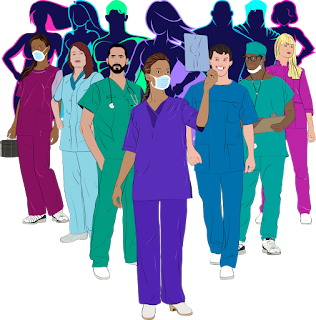As the numbers of the mortality and morbidity of the COVID-19 rise, we all see where the process broke down. But looking in-depth, a bunch of systems failed us.
In America, getting the masks is chain of commands. As of March 26, 2020, it is recorded in the SNS site that more than 529 tons of cargo were shipped to support the PPE needs. But where are they? The persistent shortage of surgical masks, N95’s, and face-shields not only thwarts our existence but it is also a nuisance to acquire them from work. Many states have their own stockpile, with permission from the Center for Disease Control and Prevention (CDC) and the Food and Drug Administration (FDA). If the State runs out of PPE supplies, it requests a federal stockpile through the Governor or Representative. The hospitals will then work with the Public Health Department for access of supplies. My question is, where are the PPE’s? And who is accounting them and how are they allocated?
[post_ads] So as I hold on to my one and only allocated PPE for the day, I challenge my superior for the safety of re-using my mask throughout the day. This is when the Center for Disease Control and Prevention comes into play. I am told that CDC has changed their guidelines. Every year, as a requirement for our job, we are fit-tested for the N95 masks for a seal check to avoid exposure to airborne pathogens such as COVID-19. Ideally, these masks are single-use only per manufacturing standards. When COVID-19 came, the CDC did not change this policy of the masks being single-use only, but when the reported cases were rising and there was a shortage of supply on the national level, the CDC changed its policy to reuse masks and advised healthcare workers for their extended use.
The Center for Disease Control now recommends that the masks can be worn between 2 different patients who are both positive for COVID-19. To deal with this personal protective equipment, shortage, the CDC left it to the hospital’s Occupational Health and Infection Control Departments to decide on how to deal with this PPE shortage. As healthcare workers who are on the front line amidst the pandemic, we have been reusing our masks and placing them in paper bags, grossly cross-contaminating ourselves by placing the masks into a bag and inhaling the pathogens. As of face shields, we wipe them with sanitizing wipes, then place them into the ultraviolet radiation, and into the bag.
In addition to that, all COVID-19 rule-outs, for best practice, should be handled as positive cases until the results come back negative. Patients like these are treated with airborne precautions, and should be placed in negative pressure rooms with the N95 masks to be worn inside the rooms. Instead, we find ourselves taking care of these patients in a regular room, with only the regular blue surgical masks to protect us. Because not everyone comes with the overt signs and symptoms, we could be exposing ourselves in a very close contact for prolonged periods of time, until the results come back a day later or even longer. Recently, the CDC also claims that the models of N95 masks that have surpassed their shelf- lives continue to perform in accordance to National Institute for Occupational Safety and Health standards (NIOSH). Why? Because some of the N95 masks that the National Stockpile distributed had surpassed their shelf lives dating back as 2013 and even 2007. This was all what America had. And again, CDC has bent policies to accommodate the chaos.
So looking deeper, Occupational Safety and Health Administration (OSHA) comes in, or does not come into play. Amidst all this violation of our safety and great of a risk in our jobs, where are they? Every year, OSHA visits the hospitals without amiss, making sure that hospitals are complying with standards. We are exposed to pathogens, day in and day out, yet how is this agency now so muted when front line healthcare workers are being added to the mortality and morbidity statistics in the US? There are more Doctors and Nurses who are thrown into those statistics from direct patient care, ending up on ventilators and dying. This is more than an occupational hazard, it is an occupational sentence.
Going back to the normal pre-pandemic state, let’s take a look at this reimbursement system of the American Healthcare. By starting with the Department of Health and Human Services, it decided to base the 30% of Medicare reimbursement to hospitals on surveys done by the patients upon discharge from the hospitals. These surveys are done through the Hospital Consumer Assessment of Health Care Providers and Systems, which uses data collection as a methodology for measuring patients’ perception of the hospital experience. There are 29 questions in the survey, 19 of which ask questions mostly related to the front line healthcare workers’ quality of “delivering care”, such as communication with doctors and nurses, responsiveness to hospital staff, and communication of medicines. Its goal is to do public reporting to enhance accountability in healthcare.
They claim that the survey is credible, useful, and practical. However, the survey is strongly flawed as it does not necessarily reflect the quality of care received. For example, the one filling in the survey may be the one who came in for a minor complaint with a dissatisfaction of one hospital meal, as opposed to a critical care patient that I may have resuscitated twice to save his life, placed on a ventilator and dialyzed on the bedside with 10 drips running into his vein, and survived. How do you compare the quality of care and claim it as credible, useful, and practical? Hospitals with high scores will receive a reimbursement in millions and bonus funding. Health insurances are following the lead of the government called, Hospital Value-based Purchasing Program or Value-based Care. So where do front line healthcare workers play? We meet the scores, we perform to satisfy the customers in order to get the hospitals a higher score. I’ll be fetching iced ginger ale for a patient in order to increase the score, while at the same time I’m titrating a vasoactive drip on a patient losing his blood pressure on the other room. In return to the excellent customer service we provide, the hospitals get the big bucks bonus.
Then there is the Joint Commission On Accreditation of Health Care organizations. Joint Commission was built to promote the “gold standard” of care through their core measures and inpatient quality reporting. Some reporting examples out of the many are the CLABSI or Central Line Acquired Blood Infection, CAUTI or Catheter-Acquired Urinary Tract Infection, and pressure ulcers. So to avoid these infections, my role is to bathe all my patients who have central lines, with chlorhexidine wipes every 24 hours; to wipe the catheter area every 12 hours with another kind of sanitizing wipe; and to turn my patients every 2 hours even if they weigh more than twice my weight. Facilities that maintain higher percentages of compliance with the core measures receive a higher reimbursement from Medicare and other payers.
So what does this mean to us? The demands of our jobs require a lot of skill, focus and time. We don’t just take care of the patients, we also take care and support their families. And with this compliance survey, we are put to a great deal of stress as they increase the demands to meet the scores and compliance. The costumers’ satisfaction is met at our expense. With these added demands, we are not given extra resources for frequent turning of our patients, baths, grabbing a ginger ale and so forth. That means that I have to skip my lunch because I have so many tasks at hand. If the scores drop, we are hounded by our superiors and we will hear it at the first hour before the start of shift.
When the government places agency after agency to be watchdogs on how we deliver healthcare, they are breaking our morale. However, they fail in every possible way to give support to the ones creating the scores to keep this bureaucracy running. Other than nursing blogs and Nursing Unions, we are very under-represented by the government. Why can’t we make a National representation for the healthcare workers? Why can’t the government make it illegal to over staff Nurses and overload Doctors with high patient ratios because such is an unsafe practice that promotes more errors and misses? And since public reporting is advocated, why can’t the healthcare workers do an even share of the survey to show how the hospitals are run, and make this survey also available for public? This public reporting on our side will create a transparency of the employees’ satisfaction to the consumers. What about delegating a part of the bonus to the healthcare workers or keeping track and ensuring that part of it goes to improve staffing, more equipment, and better programs? What about programs that will equip us with better coping since we are stretched constantly beyond our morale? Other countries like New Zealand allow their nurses to call off for a mental health day — why can’t we have that? What about making it a crime to place the healthcare workers at risk of their lives for not using the proper PPE by bending the policies?
[post_ads] When President Trump mentioned about the trillion stimulus, nothing is mentioned about hazard pay or compensation package for the healthcare workers already quarantining themselves away from their families for possible exposure due to inappropriate PPE. Again, where was the mention of a hazard pay to the frontline healthcare workers?
It is the grid of the greed; the lattice that makes up the corporate healthcare system that is broken in every level. Yet we are the ones in the frontline that make this show happen. Without us, there is no production. We are the foundation, without us, it will fall. It is not a crime to speak up, especially when enough is enough. This is America, this is how it is played. It is ugly, and it needs to change.Dems fought for hazard pay for frontline workers in this coronavirus response bill. The GOP blocked it.— Chuck Schumer (@SenSchumer) March 31, 2020
President Trump must give them hazard pay now.
If he doesn't, we'll keep fighting for it for nurses, doctors, FEMA, workers in distribution centers, grocery stores, and more.
References:
Robbins, Alexandria. The Nurses. Thomas Allen and Sons Limited, 2015. p.212phe.gov/about/sns/Pages/about.aspx
phe.gov/about/sns/Pages/responses.aspx
cdc.gov/niosh/topics/hcwcontrols/recommendedguidanceextuse.html
cdc.gov/coronavirus/2019-ncov/hcp/healthcare-supply-ppe.html
cmc.gov/Medicare.Quality-Initiative-Patient-Assessment-Instrument/QualityMeasures
jointcommission.org/en/measurement/measures
















0 Comments